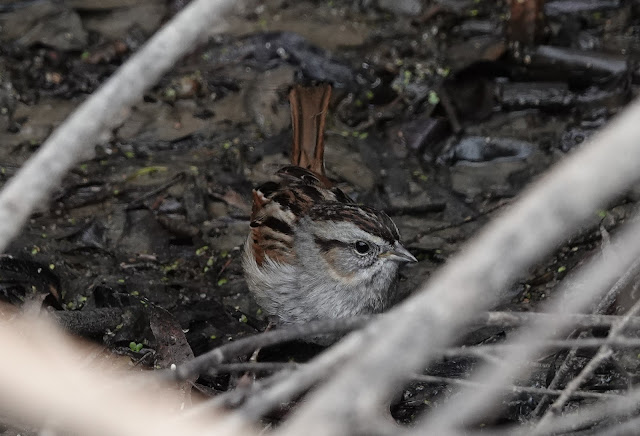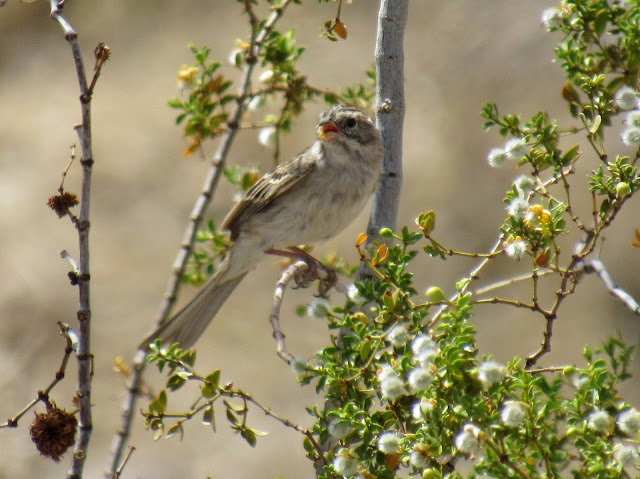Sparrows, Sparrows Everywhere!
2021 has been the year of the sparrow for me, with several rarities turning up near home, a successful Harris's Sparrow chase, and the discovery of a couple breeding pairs of Grasshopper Sparrows (a Species of Special Concern in California) in one of my local birding patches.
Boring and brown and altogether uninteresting to nonbirders, I find sparrows, in all their vast array and subtle markings, just beautiful! And most of them sing lovely songs as well!
Sparrows belong to the family Passerellidae, which also includes juncos and towhees. Fifteen species of sparrows are relatively common in California's Great Central Valley and surrounding foothills, with various species likely to be encountered in different habitats and at different times of the year.
But I can promise you that on any birding outing, you will meet at least a few sparrows!
Now, it's time to meet them all - albeit briefly - in one place.
Like meeting the fiancé's entire extended family at one overwhelmingly massive Christmas party.
Happy Holidays, guys!
*Seasons listed below (in parentheses) denote when each species is found in California's Great Central Valley and foothills.
Lincoln's Sparrow (Fall through spring)
Easily identified by its tiny black stovepipe hat and beard (just kidding!), the Lincoln's Sparrow is a small bird of damp thickets, where it generally stays fairly low in concealing vegetation.
 |
| Lincoln's Sparrow. ID key: Delicate, fine streaking and a buffy wash on the flanks. |
Song Sparrow (Common and abundant year-round resident)
Venture into any wetland area in the spring, and you will assuredly hear the lusty singing of the aptly-named Song Sparrow, which typically stays fairly low in marshy vegetation, but perches conspicuously to sing.
 |
| Song Sparrow. ID key: Messy streaks converging in a central breast spot. |
Fox Sparrow (Fall through spring)
Chunky and round, with a doe-eyed appearance and blotchy streaking, the Fox Sparrow hangs out near the ground in thickets and wooded areas, often scratching at the leaf litter in search of a tasty morsel.
Click here for more on our local Fox Sparrows!
 |
| Fox Sparrow. ID key: A large, dark reddish sparrow, with arrow-shaped breast spots, a thick bill and gentle expression. |
Rufous-crowned Sparrow (Year-round resident)
A "skulker" of rocky hills, the Rufous-crowned Sparrow favors the brushy, bouldery foothills surrounding the Central Valley, where it is found reliably in our area at Knight's Ferry and Del Puerto Canyon.
Click here for more about Rufous-crowned Sparrows.
 |
| Rufous-crowed Sparrow. ID key: A reddish crown, white eye-ring and dark whisker line. |
Chipping Sparrow (Most common during spring and fall migration; a few may overwinter(?))
Dainty and diminutive, most Chipping Sparrows merely pass through the Valley, stopping in grassy park-like areas and backyards (where they occasionally visit feeders) on their way to and from breeding grounds in the mountains and to the north.
Follow this link for more about my backyard Chipping Sparrows!
 |
| Chipping Sparrow. ID key: A small sparrow with an un-streaked breast and well-defined black eyeline. |
Lark Sparrow (Year-round resident)
One of our coolest-looking sparrows, the boldly patterned Lark Sparrow favors open areas of bare ground near brushy edges, particularly in farmland and grassland areas. (These guys also sing some of the neatest sparrow songs, which I think sound... a little like a cartoon robot running its computations!)
 |
| Lark Sparrow. ID key: That face! Also, an un-streaked breast marked by a single spot, and a tail edged with white. |
Bell's Sparrow (Year-round resident)
Preferring areas of sagebrush and chaparral, this is another species that eschews the Valley proper in favor of the foothills of the Coast Range, and, to a lesser extent, the Sierra foothills. A species very similar to Bell's, the Sagebrush Sparrow, is found in similar habitat east of the Sierran crest, and until recently the two were considered to be one in the same.
Click here for more about Bell's Sparrows.
 |
| Bell's Sparrow. ID key: A grayish, un-streaked sparrow with a white eye-ring and central breast spot. |
Savannah Sparrow (Common and abundant fall through spring)
A bird of open grasslands, these guys are all over the place during the cooler months. On the coast, they are year-round residents.
Learn more about Savannah Sparrows here!
 |
| Savannah Sparrow. ID key: Extensive streaking, yellow in front of the eyes, and a short, stubby-looking tail. |
Vesper Sparrow (Fall through spring)
Another grassland bird, the Vesper Sparrow visits us during the winter months, often mixing with flocks of other sparrows in dry, open habitats.
 |
| Vesper Sparrow. ID key: Larger than Savannah Sparrow, with prominent white eye-ring and white outer tail feathers obvious in flight. |
Grasshopper Sparrow (Spring through fall)
Distinctly flat-headed and large-billed, with a buzzing, insect-like song, the Grasshopper Sparrow is a master of camouflage in the dry grassland habitats it favors.
Read about my dance with the Grasshopper Sparrow here!
 |
| Grasshopper Sparrow. ID key: Uniquely shaped head for a Western sparrow, with white eye-ring, central white stripe on crown and an un-streaked breast and heavily striped and patterned back. |
White-crowned Sparrow (Common and abundant, fall through spring)
Very common in the Valley in the winter, White-crowned Sparrows can be found in a variety of habitats, from urban parks and gardens to farmland and wooded areas, provided there is a patch of thicket, which they so dearly love, available to them. Eric and I affectionately call these familiar little guys "Badger-headed Sparrows."
 |
| White-crowned Sparrow. ID key: The conspicuous and dapper black-and-white striped crown, orange bill and plain gray breast. (Note: First-winter birds have chestnut and gray striped crowns.) |
Golden-crowned Sparrow (Fall through spring)
A western specialty, these large, dark sparrows breed in Alaska and western Canada, moving south into the Pacific Northwest and California for the winter, where they are commonly found with White-crowned Sparrows, foraging in the undergrowth of wooded and park-like areas.
 |
| Golden-crowned Sparrow. ID key: Dark color overall, un-streaked gray breast and dark bill; in spring, the black head stripes and golden crown become especially prominent. |
Dark-eyed Junco (Most abundant fall through spring)
Undeniably adorable, juncos breed in mountain forests of the north and west, moving south, and downslope into the Central Valley, during the winter, when they can be found in woodland and park-like areas, as well as backyards.
 |
| Dark-eyed Junco. ID key: White outer tail feathers and a pink bill; in our area, the Oregon race, distinguished by a brown back and black hood, is the most common. |
California Towhee (Year-round resident)
Like juncos, towhees are just sparrows that go by an alias. California Towhees favor dry woodlands and chaparral areas, where they spend most of their time scuffling through the leaf litter, under the protection of dense shrubs.
 |
| California Towhee. ID key: A chunky, soft brown body, lightly marked face, and long tail with orange undertail coverts. |
Spotted Towhee (Year-round)
Common in woodlands and chaparral, Spotted Towhees stay relatively low to the ground, often foraging beneath shrubs by scratching through the leaf litter.
 |
| Spotted Towhee. ID key: Large size and striking markings, which include white spots, rusty flanks, a black hood, and red eyes. |
Bonus Sparrows!!
Now and then, mostly in the winter, rare sparrows that should be elsewhere turn up in the Central Valley.
White-throated Sparrow (Rare, in winter)
An Eastern species, just a few White-throated Sparrows turn up in the Central Valley each winter, where they are found foraging on the ground in park-like areas, mixed with flocks of White-crowned and Golden-crowned Sparrows, both of which are fellow Zonotrichia sparrows.
 |
| White-throated Sparrow. ID key: Striped crown (some individuals have tan rather than white stripes) with yellow patches near the eye, conspicuous white throat, and a dark bill. |
Swamp Sparrow (Rare, in winter)
Vaguely similar in size, shape and general color palette to our common Song Sparrow, Swamp Sparrows breed across much of the northeastern United States and Canada. A small number winter of the coast of California, and occasionally one of these birds strays east into Central Valley wetlands.
 |
| Swamp Sparrow. ID Key: Gray and brown striped crown, un-streaked throat and chest, reddish wings and buffy flanks. |
Harris's Sparrow (Rare, in winter)
The strikingly beautiful Harris's Sparrow breeds in the northern reaches of central Canada and winters on the southern plains of Kansas, Oklahoma and Texas. Once in a while, an individual strays off course and finds its way to the Central Valley of California, causing great excitement in the birding community!
Read about our great Harris's Sparrow chase here!
 |
| Harris's Sparrow. ID key: Large size, white belly, black face (absent in immature birds) and pinky-orange bill. |
Clay-colored Sparrow (Rare, in winter)
Small and delicate-looking, the Clay-colored Sparrow breeds on the northern plains and winters in Mexico, only very rarely finding itself in the Central Valley instead.
 |
| Clay-colored Sparrow. ID key: Small size, gray collar, finely marked face, orange bill. |
Brewer's Sparrow (Rare, in spring and fall migration)
Another rarity, the Brewer's Sparrow breeds in the sagebrush flats east of the Sierra Nevada, only occasionally making it over the crest to find itself in the grasslands east of the Central Valley.
 |
| Brewer's Sparrow. ID key: Un-streaked breast, subtle eye-ring and a relatively plain face. |
The ones that got away...
One more uncommon species has thus far evaded me, but is worth mentioning.
Black-chinned Sparrow is an uncommon summer breeder in central California, more common in Southern California. Here, this small and quiet sparrow is occasionally found in the dry chaparral and oak scrub of the foothills surrounding the Central Valley.







Comments
Post a Comment